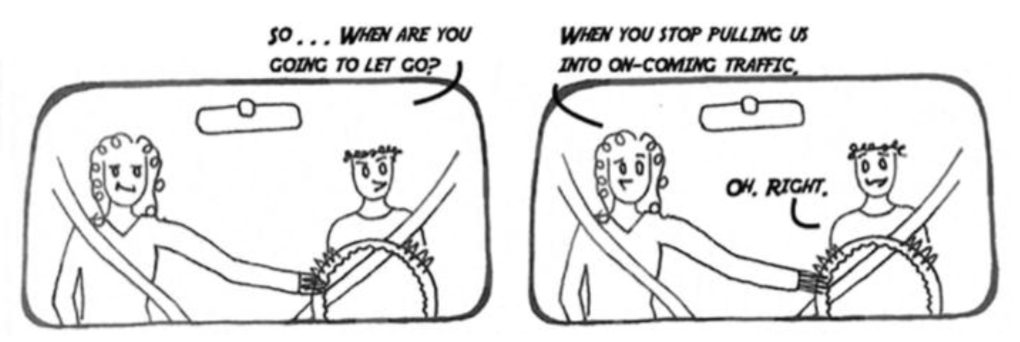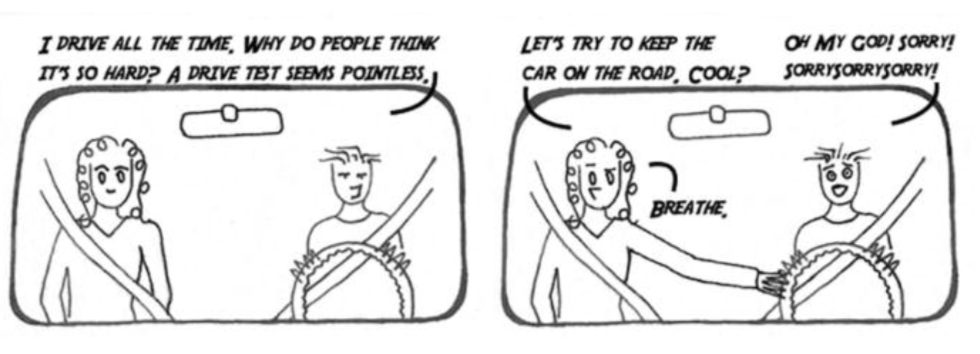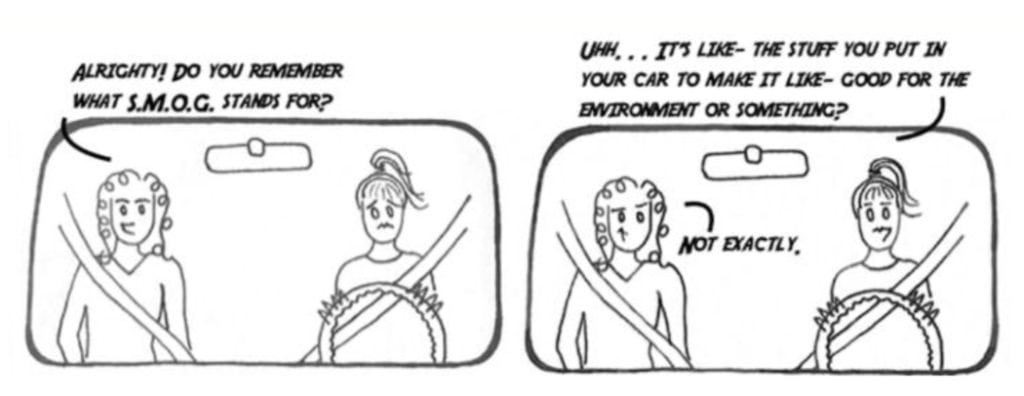Secrets of a Driving Instructor
A Lesson in Teaching from a Pro
By Ann Carin Nilland


Getting a drivers license is one of the biggest, and sometimes the most casually acquired, responsibilities that a young adult can take on. As a parent/guardian, the feelings you experience when your child becomes a student driver can be similar to when they were born. It’s exciting, terrifying. and stressful. There is a new financial responsibility, and it is life altering. I’ve been a driving instructor for nearly two years. It’s a funny job, and I like it very much. When you find yourselves teaching your student driver something complex and dangerous, but at the same time has become second nature to you, parents need all the help they can get. The view from the passenger seat can leave you shaken, but if you and your student driver prepare, it can be fun!
Being a safe driver is like a philosophy for life. We get into the driver seat and head towards our destination. Sometime you have to look at what’s behind you in order to see the best way forward. We try to be good communicators by indicating our direction, but sometimes we end up flipping the bird… We try to avoid dangerous collisions and fender-benders, but if they become inevitable we hope to survive them so we can learn and continue on our way. There are laws that we follow – and some that we don’t. Judging others for the laws they break can be a funny heckling pastime or a dangerous rage-filled habit. And I don’t know about you, but even if I’m doing everything right, I never find myself at ease while I’m being followed by a cop.

Most of us have been drivers and passengers for a long while. One thing we have been programed to do is let the driver drive – don’t grab the wheel for any reason. This is not the case with student drivers. They need help sometimes. Just remember that when you do grab the wheel be very slight about it. No wild swerving that could ruin your day. Stay calm. You know your student driver better than most. Be prepared for their typical reaction to embarrassment, then counter it as best you can. And be kind to yourself. When you’re done teaching, the lesson is over. This goes for your student driver too. If they start behaving similarly to when they were three and needed a nap, call it a day, and pick it back up tomorrow.
Driving involves independence, responsibility, and an unending onslaught of choices in an unpredictable environment. These are learned skills, and even the most confident student drivers need your full attention. These days, a new student driver is required to complete a 30 hour instruction course online before taking the DMV’s written test. The practical application of that knowledge can be mixed with apprehension and even fear. The calmer you are the easier it will be for your student driver to stay calm themselves.
In 1990, California pulled the funding that paid for the driver’s training in public schools. For a while parents would pay the cost, but eventually schools began to drop the elective from the curriculum. The state still requires classroom-based driver’s education, but that law is largely ignored. This leaves students’ behind-the-wheel instruction to licensed driving schools. And thank goodness too, because that’s where I come in.
Some parents decide to get their student driver into the drivers seat before their first official lesson. If you’re wondering whether or not that is the way to go with your student driver, you have to consider the situation. If it’s a public road, it’s not legal. Student drivers are supposed to get their first go in the drivers seat with a licensed instructor. Some of the potential penalties for driving before the first lesson are fines, court fees, as well as the payment of towing and impound fees. Sometimes students drivers loose their permit until they are 18.

S.M.O.G. stands for Signal, Mirror, Over the shoulder, Go. Signal, use your blinker to communicate your intentions to other drivers, pedestrians, or cyclists.. Mirror, you check your rearview mirror first making sure of all the activity going on behind you and then you check your side view mirror in whichever direction it is you intend on going. Over the shoulder, glance over the shoulder in the direction you intend on going in order to make sure there are no cars, pedestrians, or cyclists in your blind spot. Go, once your eyes are facing front you – well, you go!
This is a tool that should be used every time you change lanes, enter the freeway, pull over to park, pull away from a parking spot and every time you turn right.
You might be wondering why you should do it when you turn right, and that’s no surprise. In order to reduce the number of traffic incidences involving cyclists, California has recently adopted new safety requirements for drivers when they interact with the bike lane. When drivers cross it they have to do what they would for any other lane change. When drivers turn right they are cutting across the bike lane, and the idea with this new law is that they change lanes into it so that cyclists have to slow down behind them – instead of being hit by the the car.

It’s not always easy to know how to navigate this new stage in life. Even if your student driver grew up in town, even if they’ve been a passenger on the journey to the store a hundred times, being in the drivers seat changes a student drivers perspective so drastically that sometimes knowledge takes a backseat. Ask them if they would like a reminder when turns are coming up, and try to leave a little earlier than you need to incase they make a few wrong turns.
Street names, directions, red lights, green lights, yellow lights.
Here are a couple of questions to ask your student driver before they climb into the driver seat. These will help to remind them of things they probably already know, but might forget when the pressure is on. And even if they need to be reminded of the answers to some, it will help to assure you that they are ready to take the wheel.
Who has the right-of-way at a stop sign intersection? First, pedestrians. Second, the person that comes to a stop first. Third, the person on the right. And if two drivers are traveling in opposite directions (and stop at the same time) the person going straight goes first.
What is the speed limit in a residential or business District? 25mph
Are you allowed to turn right on a red light? yes, unless there is a sign telling you otherwise.
When should you stop for a yellow light? You should consider how fast you’re going. If you are far enough from the limit line to come to a safe, gentle stop then you should.
What’s the difference between, and how do we do, a protected-left and an unprotected-left? A protected left has a dedicated green arrow light that indicates you have the right of way. If it’s just a green circle then you enter the intersection with your tires pointed straight, stop part way through the intersection to yield to cross traffic, and proceed through when there is a gap in the flow of traffic.
What do you do if you see something in the road? Slow down, check over your shoulder, and safely go around it. Never swerve!
What do you do every time you turn right, or cross the bike lane? At 200 feet before your turn you should S.M.O.G. Signal, Mirror, Over the shoulder, Go. Go meaning enter the bike lane to block potential cyclists from catching up to you when you slow for the turn, to prevent them from getting hit. Entering the bike lane should be done at least a 100 feet before the turn, not at the last second.
There might be more questions to ask them based on the kinds of road conditions you have around you. For instance they might need to know how to use a turn out lane, or what you’re supposed to do for blind turns.
With that said, Highway 17 is the most dangerous stretch of road around, and yet an alarming number of student drivers about to take their drive test have never driven it. With it in such close proximity to the lives we lead here in Santa Cruz County the likelihood of your newly-licensed teen never driving highway 17 is pretty slim. Even if you forbid it, the moment a teenager has her/his drivers license they are legally allowed to drive it – alone.
Like I said, driving has become second nature to most of us. So much of it has become common sense. Before we were driving we didn’t have a mini computer to look down at, so we were looking out at what was going on around us a bit more often than the student drivers of today. Know that they might have some weird questions, and you might not know the answers to some of them – just like in life: no mater how long we live we’ll never have all the answers.







6 Comments
Jay Jorgenson
My son wants to learn how to drive. I love the picture of the driving instructor explaining to the student to keep his eyes on the road. Thank you for the information. I’ll contact a driving school company so my son can learn how to drive.
Randy Chorvack
I love how you said that when you’re done teaching the lesson is over. Driving is scary as-is, and you don’t want extra stress or anger making it worse. I remember when I was learning to drive I was so scared of it that I was 17 by the time I got my license. If my parents weren’t patient with me, I probably would’ve never learned to drive.
dantaylor6523
This is really good article i have ever read on this topic. Please keep posting more info on this topic. For more info:- http://awdrivingacademy.co.nz/
Jenna Hunter
My dad is thinking about becoming a driving instructor and he really wants to help teach kids how to be safe out on the roads. He has been thinking about taking some lessons from a professional on how to teach others. I’ll be sure to tell him about how student drivers should actually be on the roads with a licensed instructor first and not with their parents.
Megan Alder
My daughter is going to be taking driving classes soon since she wants to learn, and be certified by a school. I loved that you made a list of the most important things to know when you’re going to be taking a driving class so that you don’t start from scratch. I will definitely send this article to my daughter so that she is more knowledgeable and prepared for her driving classes.
Driving School Auckland
Great. We take our training programs really seriously because we strongly believe that a driver is responsible for the safety of people’s lives. For more details visit – https://www.drivinglessonsauckland.co.nz/